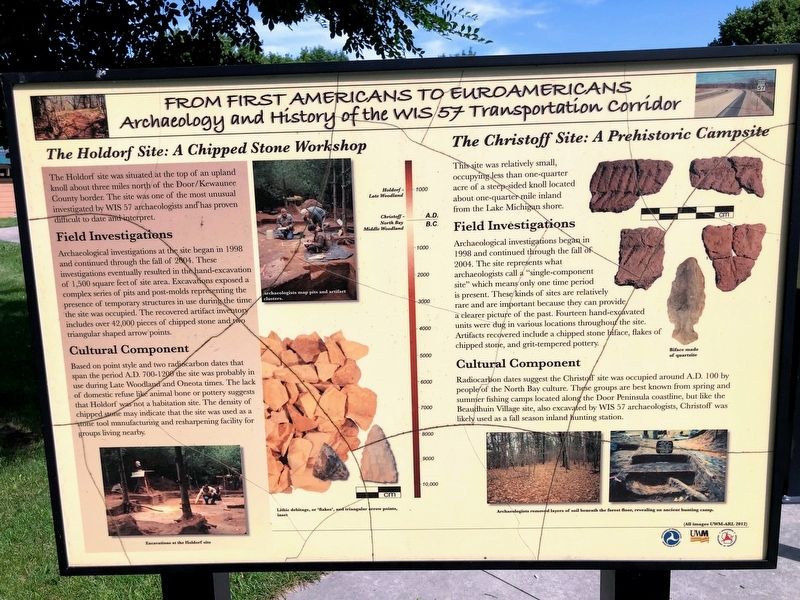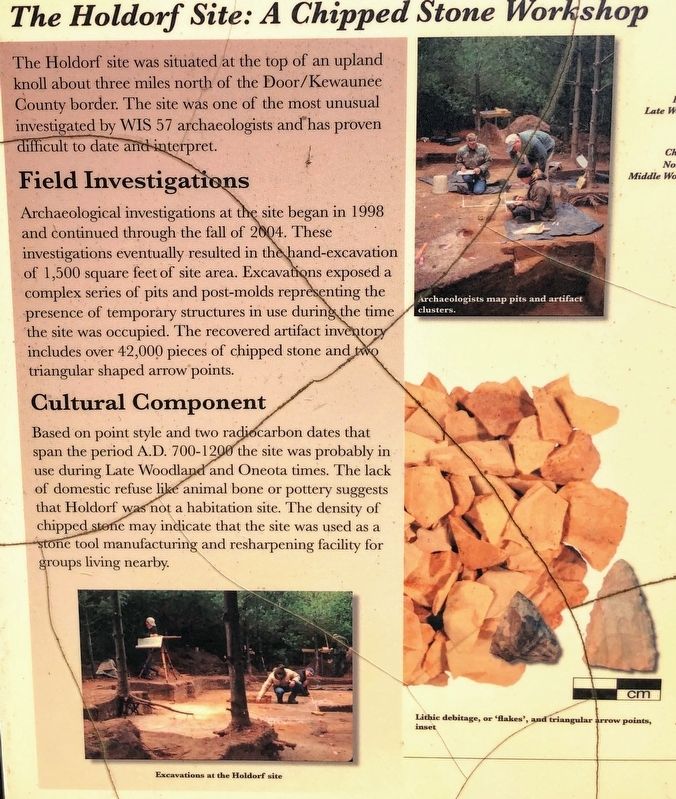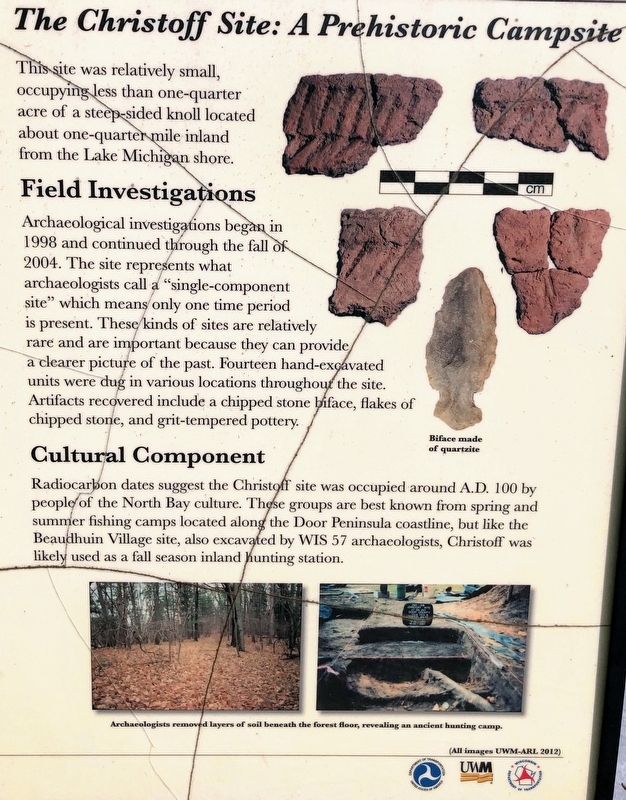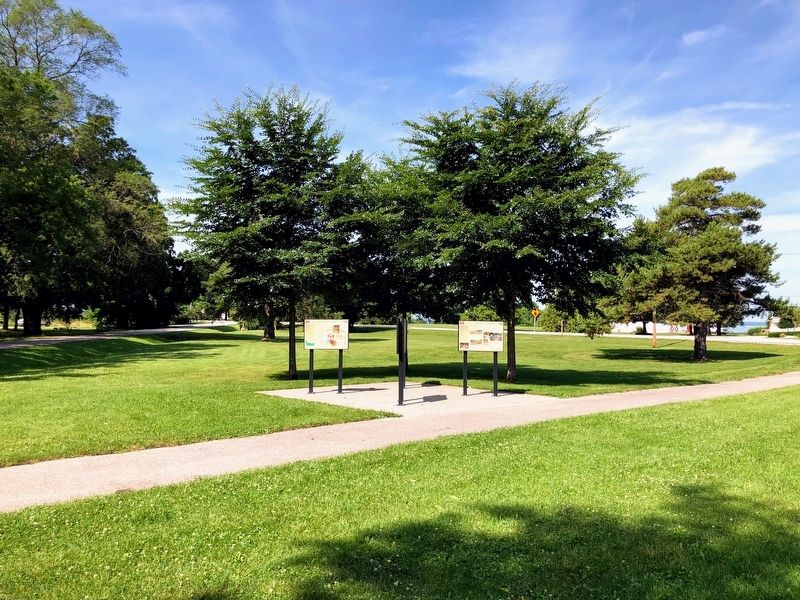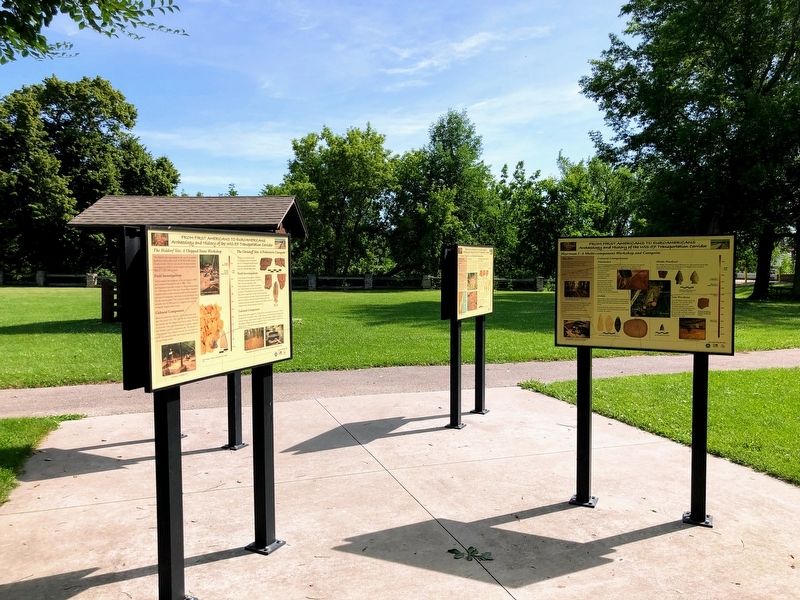The Holdorf Site: A Chipped Stone Workshop/The Christoff Site: A Prehistoric Campsite
From First Americans to Euroamericans
— Archaeology and History of the WIS 57 Transportation Corridor —
The Holdorf site was situated at the top of an upland knoll about three miles north of the Door/Kewaunee County border. The site was one of the most unusual investigated by WIS 57 archaeologists and has proven difficult to date and interpret.
Field Investigations
Archaeological investigations at the site began in 1998 and continued through the fall of 2004. These investigations eventually resulted in the hand-excavation of 1,500 square feet of site area. Excavations exposed a complex series of pits and post-molds representing the presence of temporary structures in use during the time the site was occupied. The recovered artifact inventory includes over 42,000 pieces of chipped stone and two triangular shaped arrow points.
Cultural Component
Based on point style and two radiocarbon dates that span the period A.D. 700-1200 the site was probably in use during Late Woodland and Oneota times. The lack of domestic refuse like animal bone or pottery suggests that Holdorf was not a habitation site. The density of chipped stone may indicate that the site was used as a stone tool manufacturing and resharpening facility for groups living nearby.
The Christoff Site: A Prehistoric Campsite
This site was relatively small, occupying less than
one-quarter acre of a steep-sided knoll located about one-quarter mile inland from the Lake Michigan shore.
Field Investigations
Archaeological investigations began in 1998 and continued through the fall of 2004. The site represents what archaeologists call a "single-component site" which means only one time period is present. These kinds of sites are relatively rare and are important because they can provide a clearer picture of the past. Fourteen hand-excavated units were dug in various locations throughout the site. Artifacts recovered include a chipped stone biface, flakes of chipped stone, and grit-tempered pottery.
Cultural Component
Radiocarbon dates suggest the Christoff site was occupied around A.D. 100 by people of the North Bay culture. These groups are best known from spring and summer fishing camps located along the Door Peninsula coastline, but like the Beaudhuin Village site, also excavated by WIS 57 archaeologists, Christoff was likely used as a fall season inland hunting station.
Topics. This historical marker is listed in these topic lists: Anthropology & Archaeology • Native Americans.
Location. 44° 34.083′ N, 87° 52.78′ W. Marker is in Scott, Wisconsin, in Brown County. Marker is on Bay Settlement Road north of VanLaanen Road,
Other nearby markers. At least 8 other markers are within walking distance of this marker. The WIS 57 Reconstruction Project in Brown, Kewaunee, and Door Counties (here, next to this marker); Delfosse-Allard: A Multi-component Site (here, next to this marker); Heyrman I: A Multi-component Workshop and Campsite (here, next to this marker); From First Americans to Euroamericans (here, next to this marker); Transportation Archaeology on the WIS 57 Project (here, next to this marker); Fabry Creek (Boss Tavern): A Multi-component Site (here, next to this marker); The Beaudhuin Village Site: A North Bay Middle Woodland Camp (here, next to this marker); Red Banks (about 500 feet away, measured in a direct line). Touch for a list and map of all markers in Scott.
More about this marker. This marker is part of the group of markers at this location titled From First Americans to Euroamericans: Archaeology and History of the WIS 57 Transportation Corridor. The markers are a few steps from the southern parking lot in the Wequiock Falls County Park.
Credits. This page was last revised on December 16, 2019. It was originally submitted on December 14, 2019, by Devon Polzar of Port Washington, Wisconsin. This page has been viewed 228 times since then and 9 times this year. Photos: 1, 2, 3, 4, 5, 6. submitted on December 14, 2019, by Devon Polzar of Port Washington, Wisconsin. • Mark Hilton was the editor who published this page.
